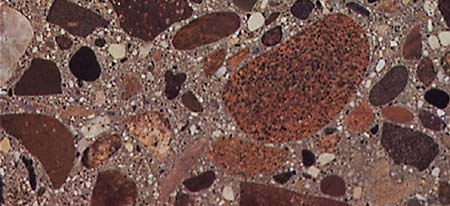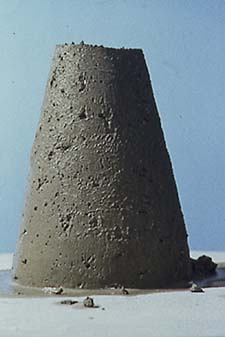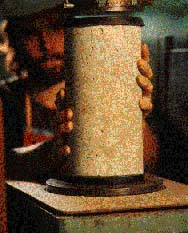Aggregates
Aggregates are generally divided into two groups: fine and coarse. Fine aggregates consist of natural or manufactured sand with particle sizes ranging from dust-size up to 3/8 inch; coarse aggregates are those with particles ranging in size from 6 in. down to about 0.05 in. For pavement, it is common for the maximum aggregate size to range from 1 to 1.5 in. Aggregates are sized by passing them through screens with standard openings called sieves.
 |
Selection of aggregates for use in concrete is important since they make up about 60% to 75% of the total volume of concrete.
Aggregates should consist of particles with adequate strength and resistance to exposure conditions and should not contain materials that will cause a chemical reaction with the paste that may lead to deterioration of the concrete. Screening tests are available to determine the adequacy of aggregates for use in concrete. |
Cement Paste
The paste is composed of portland cement, supplementary cementitious materials (fly ash), water, and entrapped air or purposely entrained air. Cement paste ordinarily constitutes about 25% to 40% of the total volume of concrete. The volume of cement is usually between 7% and 15% and the water between 14% and 21%. Air content ranges up to about 8% of the volume of the concrete.

Cut away of Concrete showing Aggregate and Paste
There are many different types of cement, including portland cement and blended hydraulic cement. ASTM C150 and AASHTO M85 classify portland cements by five chemical and compositional designations: Type I through Type V. ASTM C 595 and ASTM C 1157 classify blended hydraulic cements. Blended cements contain additional ingredients, such as fly ash, or blast furnace slag directly in the cement. Presently, most concrete for use in pavement is made with a portland cement, but use of blended hydraulic cements appears to be increasing.
Concrete Quality
The quality of any concrete is dependent upon the ratio of the quantity of water used to the quantity of cementitious materials used in the mixture (called the water-cement ratio or water-cementitious ratio). In general, concrete with a lower water-cementitious ratio is stronger and less permeable, thus more durable.
The freshly-mixed and hardened properties of concrete may be changed by adding liquid or mineral admixtures to the concrete, during batching. Admixtures are commonly used to (1) adjust setting time or hardening, (2) reduce water demand, (3) increase workability, (4) intentionally entrain air, and (5) adjust other concrete properties, such as strength.
Air bubbles are entrained in concrete using an air-entraining admixture. The tiny microscopic bubbles provide free space within the paste to relieve hydraulic pressure when concrete freezes. Without the bubbles, the paste may crack when it freezes because water expands 9% in volume when it turns to ice. With entrained air, there is free space within the concrete to relieve pressure in the paste during freezing.
There is also some air – entrapped air – that gets trapped in the concrete during mixing. In general, entrapped air voids are much larger than entrained air bubbles and provide no real benefits. Any concrete with a large number of entrapped air voids will probably have lower strength and durability. Entrapped air is often the result of a very harsh or sticky mixture and/or lack of effort in consolidating a mixture.
Consistency
Workability is the ease of placing, consolidating, and finishing freshly mixed concrete. In general, freshly mixed concrete is plastic or semi-fluid with the consistency of thick mud. However there are degrees of plasticity necessary for different uses of concrete. This consistency is often measured by the slump of the concrete. Paving concrete has usually a low-slump (stiff consistency.)
Consolidation is the process of inducing a closer arrangement of the solid particles in freshly mixed concrete. During consolidation entrapped air is removed from the concrete. For most pavement construction processes hand-held or paving machine vibrators impart energy on concrete to achieve consolidation. The vibrators operate at a high frequency and set aggregate particles into motion in freshly mixed concrete, reducing friction between them and giving the mixture the qualities of a thick fluid. This allows the concrete to flow easily through a slipform paver, and around reinforcing steel, dowel baskets and other embedded fixtures. |

Slump Test after Removing the Cone |
Strength
Concrete pavement strength is usually evaluated in compression or in flexure. These values are called compressive strength and flexural strength and are determined using standardized tests.
For compressive strength, imagine placing a small sample of concrete in a vise and squeezing until it breaks. If you measure the squeezing (compressing) force necessary to break the concrete and divide by the contact area of the specimen, you will determine the compressive strength. It is generally expressed in pounds per square inch (psi) at an age of 28 days. (Concrete continues to gain strength with age. To account for this, the strength used in designing and specifying concrete is measured at 28 days.)
 |
To determine compressive strength, tests are made on cylinders, which are often sized at 6 inches in diameter and 12 inches high. Most paving-grade concrete has a compressive strength between 3000 psi and 5000 psi. High-strength concrete has a compressive strength of at least 6000 psi and compressive strengths of 20,000 psi have been used in building applications.
Flexural strength is the strength of concrete to bending. Consider the action of holding each end of a pencil and bending the pencil until it breaks. This is an example of placing a structure in bending (flexure). In designing concrete pavements, flexural strength is often used because it better simulates what happens when a slab is loaded by a truck or other vehicle. Another term for the flexural strength is the modulus of rupture. Most general-use concrete has a flexural strength between 500 psi to 700 psi.
|


